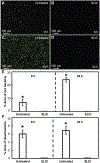Interaction of Blood and Bacteria with Slippery Hydrophilic Surfaces
- PMID: 40510515
- PMCID: PMC12162091
- DOI: 10.1002/admi.202300564
Interaction of Blood and Bacteria with Slippery Hydrophilic Surfaces
Abstract
Slippery surfaces (i.e., surfaces that display high liquid droplet mobility) are receiving significant attention due to their biofluidic applications. Non-textured, all-solid, slippery hydrophilic (SLIC) surfaces are an emerging class of rare and counter-intuitive surfaces. In this work, the interactions of blood and bacteria with SLIC surfaces are investigated. The SLIC surfaces demonstrate significantly lower platelet and leukocyte adhesion (≈97.2% decrease in surface coverage), and correspondingly low platelet activation, as well as significantly lower bacterial adhesion (≈99.7% decrease in surface coverage of live Escherichia Coli and ≈99.6% decrease in surface coverage of live Staphylococcus Aureus) and proliferation compared to untreated silicon substrates, indicating their potential for practical biomedical applications. The study envisions that the SLIC surfaces will pave the path to improved biomedical devices with favorable blood and bacteria interactions.
Keywords: bacterial adhesion; hydrophilicity; platelet activation; platelet adhesion; slippery.
Conflict of interest statement
Conflict of Interest The authors declare no conflict of interest.
Figures







References
-
- Movafaghi S, Wang W, Bark DL, Dasi LP, Popat KC, Kota AK, Mater. Horiz 2019, 6, 1596; - PMC - PubMed
- Zhang P, Lv FY, Energy 2015, 82, 1068;
- Li J, Ueda E, Paulssen D, Levkin PA, Adv. Funct. Mater 2019, 29, 1802317;
- Cha H, Vahabi H, Wu A, Chavan S, Kim M-K, Sett S, Bosch SA, Wang W, Kota AK, Miljkovic N, Sci. Adv 2020, 6, eaax0746; - PMC - PubMed
- Lee C, Choi C-H, Kim C-J, Exp. Fluids 2016, 57, 176;
- Wang W, Sun J, Vallabhuneni S, Pawlowski B, Vahabi H, Nellenbach K, Brown AC, Scholle F, Zhao J, Kota AK, Mater. Horiz 2022, 9, 2863; - PMC - PubMed
- Channon RB, Menger RF, Wang W, Carrão DB, Vallabhuneni S, Kota AK, Henry CS, Microfluid. Nanofluid 2021, 25, 31.
-
- Vallabhuneni S, Movafaghi S, Wang W, Kota AK, Macromol. Mater. Eng 2018, 303, 1800313;
- Tuteja A, Choi W, Ma M, Mabry JM, Mazzella SA, Rutledge GC, Mckinley GH, Cohen RE, Science 2007, 318, 1618; - PubMed
- Sutherland DJ, Rather AM, Sabino RM, Vallabhuneni S, Wang W, Popat KC, Kota AK, ACS Sustainable Chem. Eng 2023, 11, 2397; - PMC - PubMed
- Epstein AK, Wong T-S, Belisle RA, Boggs EM, Aizenberg J, Proc. Natl. Acad. Sci. U.S.A 2012, 109, 13182; - PMC - PubMed
- Movafaghi S, Cackovic MD, Wang W, Vahabi H, Pendurthi A, Henry CS, Kota AK, Adv. Mater. Interfaces 2019, 6, 1900232; - PMC - PubMed
- Vahabi H, Wang W, Popat KC, Kwon G, Holland TB, Kota AK, Appl. Phys. Lett 2017, 110, 251602.
-
- Tian X, Verho T, Ras RHA, Science 2016, 352, 142; - PubMed
- Peppou-Chapman S, Hong JK, Waterhouse A, Neto C, Chem. Soc. Rev 2020, 49, 3688; - PubMed
- Hoque MJ, Sett S, Yan X, Liu D, Rabbi KF, Qiu H, Qureshi M, Barac G, Bolton L, Miljkovic N, ACS Appl. Mater. Interfaces 2022, 14, 4598; - PubMed
- Wang W, Vahabi H, Movafaghi S, Kota AK, Adv. Mater. Interfaces 2019, 6, 1900538. - PMC - PubMed
-
- Buddingh JV, Hozumi A, Liu G, Prog. Polym. Sci 2021, 123, 101468;
- Wang L, Mccarthy TJ, Angew. Chem., Int. Ed 2016, 55, 244. - PubMed
-
- Wang X, Wang Z, Heng L, Jiang L, Adv. Funct. Mater 2020, 30, 1902686;
- Zhao H, Deshpande CA, Li L, Yan X, Hoque MJ, Kuntumalla G, Rajagopal MC, Chang HC, Meng Y, Sundar S, ACS Appl. Mater. Interfaces 2020, 12, 12054; - PubMed
- Zhao H, Khodakarami S, Deshpande CA, Ma J, Wu Q, Sett S, Miljkovic N, ACS Appl. Mater. Interfaces 2021, 13, 38666. - PubMed
Grants and funding
LinkOut - more resources
Full Text Sources
